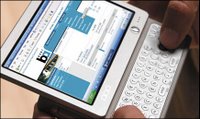My Review of Blackberry 7105tThis is a review that I posted on epinions.com this morning:
Pros
- Bluetooth headset support, small/light form factor, beautiful screen, polyphonic ringtones
Cons
- Small keyboard, difficult ringtone transfer, battery life, handicapped Bluetooth, screen dark unless active
The Bottom Line
Hard-core Blackberry users should try the keyboard before buying. Overall, a great unit combining the advantages of Blackberry with a traditional phone form factor and features.
Full Review
The Blackberry 7100 is a major step forward for the Blackberry community, although it is also a step back. I'll explain.
RIM introduced the 7100 series, which is basically the same phone for all carriers (the letter after the model indicates which carrier -- t, for example, for T-Mobile), in late 2004. I have been a user of the 'classic' brick-style Blackberry for a number of years but always desired the features and form factor of a classic mobile phone--the 7100 series seemed to be the answer.
I should mention that I use the T-Mobile network in the Denver area, although I travel globally.
I received the 7105t (which is a close cousin to the 7100--the only real difference is the screen, which is easier to read in daylight) about 3 weeks ago, and have been mostly happy with it. It is clearly a major improvement over the old line of Blackberries, but people that do a lot of text input should carefully consider the keyboard on the 7100 series.
Improvements of the 7100 series:
- Phone-like form factor (bar vs. brick); much easier to use as a phone;
- Excellent phone quality - Beautiful color screen (240x260, 65K colors)
- Bluetooth support (headset and wireless sync);
- Polyphonic ringtones (32 chords);
- Quad-band GSM world phone (works anywhere that has GSM coverage);
- Instant messaging client: supports all major IM clients (Yahoo, MSN, AOL)
- Skins: ability to change the look-and-feel of the user interface;
Drawbacks of the 7100 series:
- Handicapped Bluetooth--file transfer not supported; wireless sync only works with PC Bluetooth adapters on the Microsoft hardware compatibility list (HCL);
- Keyboard: due to the smaller form factor, RIM had to combine two letters on most keys. The 7100s do have a predictive typing system with a 35,000 word dictionary that anticipates the word being typed. This takes a bit of getting used to but works reasonably well (clearly better than other systems, such as T9), but the classic RIM keyboard is still easier and faster.
- Ringtones: The 7100 only uses ADPCM ringtones, which require conversion from standard formats. The only way to get a ringtone into the phone is to load from a Web site (e.g. you cannot transfer tones from the desktop; nor can you email a tone to yourself). The ringtones sound great, but it's much to difficult to get them there. Many phones today will accept MP3 format--not the 7100.
- Battery life: while decent, much less than the brick-style Blackberries. In real use, the 7100 lasted only 4 days on standby (much less than the 10 days standby reported by RIM); talk time is close to RIM's specs (3-4 hours).
- Screen: dark unless active (prior models were readable at all times); 7100 difficult to see in bright sunlight (corrected in 7105 model)
Overall, I'm very happy with the phone--the screen is beautiful, ringtones sound good and I love the form factor. Since I don't spend a lot of time doing text entry (mostly reading), the keyboard is fine for me, and I also love being able to use a wireless Bluetooth headset. The inability to sync via Bluetooth is not a big factor, as the phone must be plugged into USB to charge anyway.
Recommended for: Business Executives - Powerful and Professional




